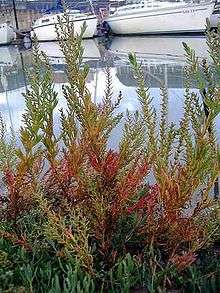Suaeda
| Suaeda | |
|---|---|
 | |
| Suaeda maritima | |
| Scientific classification | |
| Kingdom: | Plantae |
| (unranked): | Angiosperms |
| (unranked): | Eudicots |
| (unranked): | Core eudicots |
| Order: | Caryophyllales |
| Family: | Amaranthaceae |
| Subfamily: | Suaedoideae |
| Genus: | Suaeda Forssk. ex J.F. Gmel. |
| Species | |
|
About 110 | |
Suaeda is a genus of plants also known as seepweeds[1] and sea-blites. Most species are confined to saline or alkaline soil habitats, such as coastal salt-flats and tidal wetlands. Many species have thick, succulent leaves, a characteristic seen in various plant genera that thrive in salty habitats (halophile plants).
There are about 110 species in the Suaeda genus.[2]
The most common species in northwestern Europe is Suaeda maritima. It grows along the coasts, especially in saltmarsh areas, and is known in English as common seablite. It is also common along the east coast of North America from Virginia northward. One of its varieties is common in tropical Asia on the land-side edge of mangrove tidal swamps. Another variety of this polymorphic species is common in tidal zones all around Australia (Suaeda maritima var. australis is also classed as Suaeda australis). On the coasts of the Mediterranean Sea a common Suaeda species is Suaeda vera (synon. S. fruticosa). This is known as "shrubby sea-blite" in English, in distinguishment from common sea-blite. It grows taller and forms a bush. In the medieval and early post-medieval centuries it was harvested and burned, and the ashes were processed as a source for sodium carbonate for use in glass-making; see glasswort.
In Mexico, some species such as Suaeda pulvinata are cooked in traditional dishes known as romeritos.
The name Suaeda comes from an Arabic name for the Suaeda vera species and it was assigned as the genus name by the 18th century taxonomist Peter Forsskal during his visit to the Red Sea area in the early 1760s.[2][3][4]
Selected species:
- Suaeda aegyptiaca
- Suaeda aralocaspica - formerly known as Borszczowia aralocaspica, a central Asian halophyte
- Suaeda asphaltica - Asphaltic seablite
- Suaeda australis - Austral seablite
- Suaeda calceoliformis - Pursh seepweed, broom seepweed, horned seablite
- Suaeda californica - California seablite
- Suaeda conferta - beach seepweed
- Suaeda corniculata - jiao guo jian peng
- Suaeda esteroa - estuary seablite
- Suaeda glauca - jian peng
- Suaeda linearis - annual seepweed, narrow-leaf seablite
- Suaeda maritima - herbaceous seepweed
- Suaeda mexicana - Mexican seepweed
- Suaeda moquinii - Mojave seablite
- Suaeda nigra - bush seepweed, romerillo
- Suaeda occidentalis - western seepweed
- Suaeda palaestina
- Suaeda pulvinata
- Suaeda rolandii - Roland's seablite
- Suaeda salina
- Suaeda suffrutescens - desert seepweed
- Suaeda tampicensis - coastal seepweed
- Suaeda taxifolia - woolly seablite
- Suaeda torreyana - iodine weed
- Suaeda vera - alkali seepweed
References
- ↑ "Suaeda". Natural Resources Conservation Service PLANTS Database. USDA. Retrieved 4 December 2015.
- 1 2 Entry for Suaeda in Flora of North America.
- ↑ Entry for Suaeda in the Jepson Manual Online.
- ↑ Peter Forskål's book Flora Aegyptiaco-Arabica, published 1775, in Latin, declares Suæda as a newly created genus name, with the name taken from an Arabic name Suæd – said on page XXXVIII – and presents the species members of the new genus on pages 69-71.
| Wikispecies has information related to: Suaeda |
| Wikimedia Commons has media related to Suaeda. |